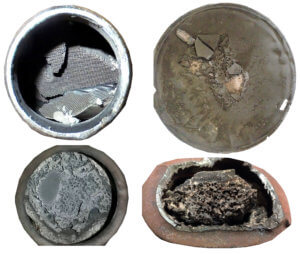Catalytic converter failure causes
Most common catalytic converter failure causes
Catalytic converters don’t die on their own — they’re murdered
Catalytic converters don’t “wear out.” They’re damaged by improper fuel mixtures, contamination or impact. Before you replace a catalytic converter due to a P0420 or P0430 code, make sure you find out what killed your present converter. If you don’t, you’ll just kill the new one.
Three most common catalytic converter failure causes
The ceramic structure overheats and melts
If your engine is misfiring, it’s not burning all

Nothing will fix these clogged and melted catalytic converters. they must be replaced
the fuel in the combustion chamber. Where it that fuel being burned? In the catalytic converter. The converter is designed to burn off some fuel, but not a constant supply of fuel. When too much fuel gets dumped into the converter, the temperature can rise above 1,600°F and the ceramic brick structure melts. Once ceramic melts, you can’t “unmelt” it. The melted portions prevent exhaust passage. In other words, the melted portion clogs the converter and it can’t be unclogged.
Causes of excessive high fuel entering the catalytic converter
• Misfires due to low compression, poor spark or no spark, rich/lean air fuel mixture, poor fuel quality, or poor fuel delivery (low fuel pressure.
• Exhaust leaks
• Sluggish O2 sensor. The O2 sensor is blamed for catalytic converter failures. A lazy O2 sensor can, in some rare cases, cause a wrong air fuel mixture that can damage the catalytic converter.
HOWEVER, most ECMs test the condition and efficiency of the catalytic converter by commanding a rapidly changing rich lean air fuel mixture and then monitoring the upstream and downstream O2 sensors. It expects the upstream sensor to react quickly to the rapid changes in air/fuel. If the upstream O2 sensors respond as expected, the ECM knows the upstream sensors are good. If not, the ECM will set an O2 sensor trouble code.
While it’s checking the upstream O2 sensors, the ECM is also monitoring the downstream O2 sensor. If the catalytic converter is doing its job, it will burn off the excess fuel and store the excess oxygen, so the downstream sensor will show close to a flat line. If the converter isn’t working problem and can’t burn off the fuel or store oxygen, the downstream sensor will respond in tandem with the upstream sensor.
To check an O2 sensor look for these switch values and rates:
Voltage should rise to 850 mV
Voltage should drop to 150mV
Never drop below 0
Voltage should switch once every 2 seconds to 5 times per second
Voltage rise time less than 80 ms
Voltage fall time should be less than 100 ms
A coated or fouled ceramic substrate can cause the catalytic converter to fail
The precious metals inside the catalytic converter must come in contact with oxygen and fuel to work properly. If the substrate is coated with coolant, silicone, oil, or soot, it won’t work properly.
In some cases, cleaners can help remove the coating. I see people use cleaners and find the the P0420 disappears. They think they’ve solved the problem. But if you don’t find and fix the problem that caused the converter substrate to be coated in the first place, it will just happen again.
Common catalytic converter “poisons”
Excessive carbon in exhaust
Internal coolant leaks (head/intake gasket)
Use of non-converter-safe gasket sealants
Excessive oil consumption (burning oil)
Improper fuels or additives (E85, diesel)
Catalytic converter structural damage
Check the converter for dents or signs of impact.
Check for thermal shock—hot converter hits cold water
©, 2022 Rick Muscoplat
Posted on by Rick Muscoplat
